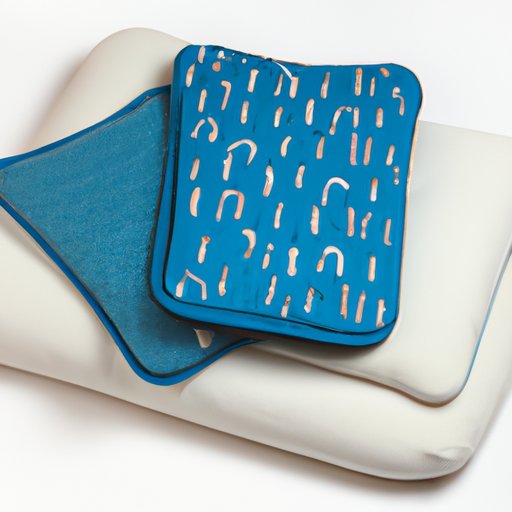Introduction
A heating pad is a device designed to apply direct or indirect heat to a localized area of the body. It can be used to relieve sore muscles, reduce inflammation, and increase blood flow to an injured area. But how long should you lay on a heating pad? In this article, we’ll explore the potential benefits and risks of using heating pads, as well as the factors that may affect the maximum length of time you can safely use one. We’ll also look at the different types of heating pads available and provide some practical tips for optimizing your heat therapy.

Exploring the Benefits and Risks of Using Heating Pads
Heat therapy has been used for centuries to treat a variety of ailments and conditions. Heat can help relax tense muscles, reduce joint stiffness, and soothe sore areas. It can also help improve circulation, which can speed up healing and reduce inflammation. However, it’s important to understand the potential risks associated with improper use of heating pads.
Potential Therapeutic Benefits
Heat therapy can be an effective way to alleviate pain and discomfort. Applying heat to an injured area can help relax the muscles, reduce stiffness, and increase blood flow. This can help speed up the healing process and reduce inflammation. Heat can also help reduce muscle spasms and tension, which can help reduce pain. In addition, heat therapy can help reduce pain from arthritis and other joint disorders.
Potential Risks Associated With Improper Use
When used improperly, heating pads can cause serious injury. If the heating pad is too hot, it can cause burns or skin irritation. Overuse of a heating pad can also lead to dehydration, nausea, and heat exhaustion. It’s important to use caution when applying heat therapy and avoid using a heating pad for extended periods of time.
How Long Can You Safely Use a Heating Pad?
The maximum length of time you can safely use a heating pad depends on several factors. Generally speaking, most experts recommend limiting your use of a heating pad to 20 minutes at a time. However, this may vary depending on the type of heating pad you are using and your individual health status.
General Guidelines for Safe Use
When using a heating pad, it’s important to follow general safety guidelines. Make sure the heating pad is not too hot and never exceed the recommended time limit. Additionally, if you feel any discomfort or pain while using a heating pad, stop immediately.
Factors That May Affect the Maximum Length of Time You Can Safely Use a Heating Pad
Your individual health status can affect how long you can safely use a heating pad. For example, individuals with certain medical conditions, such as diabetes, may need to limit their use of a heating pad due to increased risk of skin irritation or burns. In addition, the type of heating pad you are using can also affect the maximum length of time you can safely use it. Electric heating pads tend to get hotter than microwavable or chemical heating pads, so they should be used for shorter periods of time.
What to Consider Before Applying Heat Therapy
Before using a heating pad, it’s important to consider your current health status, the type of heating pad you are using, and any preexisting medical conditions. If you have any concerns about using a heating pad, talk to your doctor before starting heat therapy.

The Potential Side Effects of Excessive Heat Exposure
Excessive heat exposure can lead to a number of unpleasant side effects, including skin burns, dehydration, nausea, and heat exhaustion. To avoid these side effects, it’s important to use caution when applying heat therapy and limit your use of a heating pad to no more than 20 minutes at a time.
Understanding the Different Types of Heating Pads
There are several types of heating pads available, each with its own advantages and disadvantages. Electric heating pads are the most common type and are typically the easiest to use. They can be plugged into an electrical outlet and adjusted to the desired temperature. Microwavable heating pads are filled with materials that can retain heat, such as grains or flaxseed. They must be heated in the microwave before use. Chemical heating pads contain chemicals that produce heat when activated. These are typically single-use products and should be discarded after use.
Practical Tips for Optimizing Heat Therapy
There are a few simple steps you can take to optimize your heat therapy and ensure you are using the heating pad safely and effectively. First, make sure the heating pad is set to the correct temperature. The temperature should be warm but not too hot. Second, don’t fall asleep while using a heating pad, as this can lead to burns or skin irritation. Finally, drink plenty of fluids to stay hydrated and avoid heat exhaustion.

Examining the Pros and Cons of Using Heating Pads
As with any type of treatment, there are both advantages and disadvantages to using a heating pad. On the plus side, heat therapy can be an effective way to reduce pain and inflammation. It can also help relax tense muscles and improve circulation. On the other hand, improper use of a heating pad can lead to burns, dehydration, and other unpleasant side effects.
Conclusion
In summary, heat therapy can be an effective way to reduce pain and inflammation. However, it’s important to understand the potential benefits and risks associated with using a heating pad. Make sure to follow general safety guidelines and limit your use of a heating pad to 20 minutes at a time. Additionally, consider your current health status, the type of heating pad you are using, and any preexisting medical conditions before beginning heat therapy. By following these tips, you can ensure you are using a heating pad safely and effectively.


